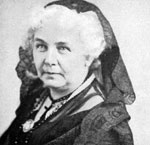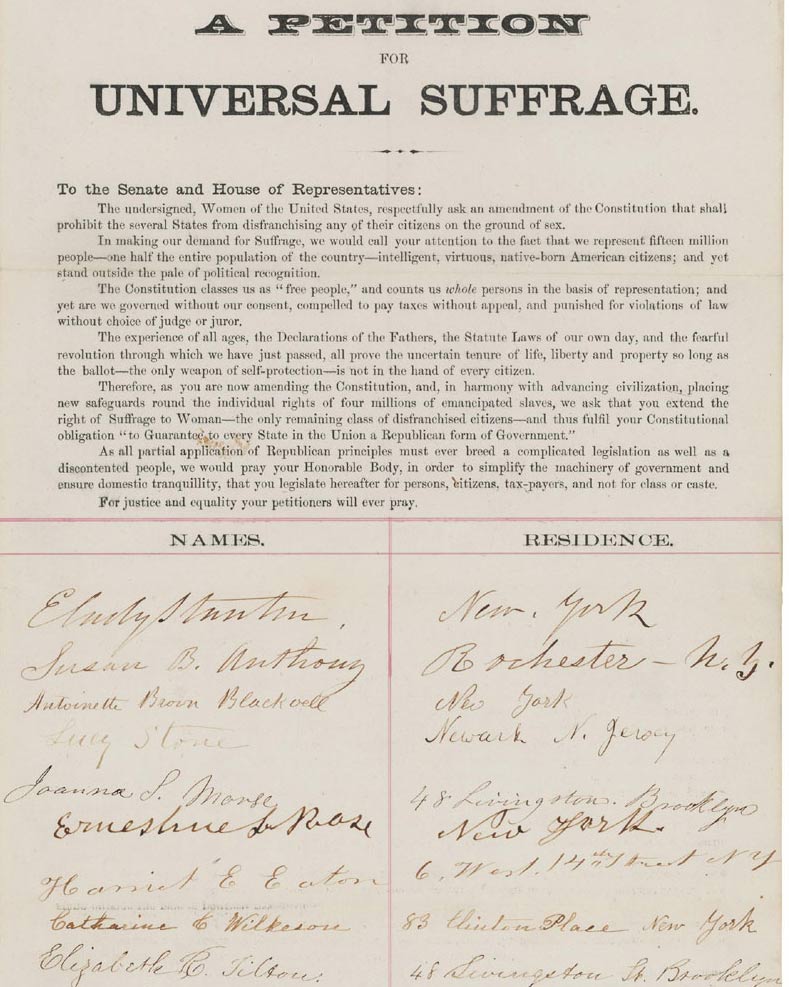Elizabeth Cady Stanton (1815-1902) – early feminist, civil rights activist and women’s rights advocate.
 Elizabeth Cady Stanton was an influential figure in the civil rights movement of the Nineteenth Century. Stanton advocated the end of slavery, and equal rights for women and black Americans. After the American civil war, Stanton became increasingly focused on the issue of female suffrage and feminist issues. She was a strong supporter of the Temperance movement, and was also critical of organised Christianity for relegating the role of women. She wrote influential pamphlets and books, including: Declaration of Sentiments and Resolutions(1848) A Petition for Universal Suffrage (1866) History of Woman Suffrage (1881-1922) The Woman’s Bible (1895-1898) She is considered by many to be one of the key founders of the women’s rights movement in the US.
Elizabeth Cady Stanton was an influential figure in the civil rights movement of the Nineteenth Century. Stanton advocated the end of slavery, and equal rights for women and black Americans. After the American civil war, Stanton became increasingly focused on the issue of female suffrage and feminist issues. She was a strong supporter of the Temperance movement, and was also critical of organised Christianity for relegating the role of women. She wrote influential pamphlets and books, including: Declaration of Sentiments and Resolutions(1848) A Petition for Universal Suffrage (1866) History of Woman Suffrage (1881-1922) The Woman’s Bible (1895-1898) She is considered by many to be one of the key founders of the women’s rights movement in the US.Early Life Elizabeth Cady Stanton
Elizabeth was born in New York, November 12, 1815. Her father, Daniel Cady was a prominent lawyer, and rose to be a New York Supreme Court Justice. Elizabeth gained a wide exposure to her father’s law library and shared his interest in law. Unlike many girls of her age, Elizabeth gained a wide ranging education, which gave her an understanding of the gender bias which discriminated against women and black people. She completed her education at the Troy Female Seminary in New York.
Early activism
Despite already holding feminist and abolitionist views, her first political activism was within the Temperance movement. It was here that she met Henry Brewster Stanton a journalist and active abolitionist. They married in 1840, and together had six children. Their marriage was long lasting, despite disagreeing on the issue of women’s suffrage. Her marriage to Henry brought Elizabeth into the leading intellectual and abolitionist circles of Boston. She came to meet prominent anti-slavery activists, such as Frederick Douglass, Louisa May Alcott and Ralph Waldo Emerson.
In 1847, the Stantons moved away from Boston to Seneca Falls in New York. Here Stanton had less intellectual company and, for a time, felt unfulfilled by her dominant role of mother and bringing up her children. However, motivated by the political issues of equality, she used her dynamism and energy to organise like minded women into a new women’s right group.
The Women’s rights movement
In 1848, Elizabeth joined with Lucretia Mott and 300 other women to organise the first women’s rights convention in Seneca Falls. It was at this conference that Elizabeth drafted and published her ‘Declaration of Sentiments‘ which declared the essential equality of women and men. Based on the US declaration of Independence, it called for universal female suffrage and extension of equal rights.
“We hold these truths to be self-evident: that all men and women are created equal; that they are endowed by their Creator with certain inalienable rights; that among these are life, liberty, and the pursuit of happiness; that to secure these rights governments are instituted, deriving their just powers from the consent of the governed.” Declaration of Sentiments (1848)
This conference of 1848, is seen as a very significant event in creating the modern movement of women’s rights in America. Elizabeth Cady Stanton became one of the leading figures and spokesperson for the movement and her activity brought her into contact with similar women, such as Susan B.Anthony. Stanton would often write speeches for Susan B. Anthony, and they shared a close friendship for over 50 years.
After the civil war, Stanton was disillusioned by many in the civil rights movement who were willing to promote universal suffrage for black and white men – in precedence over women’s rights. Stanton felt it unacceptable that rights for black men came at the cost of dropping support for female suffrage. After this point, although still a supporter of civil rights, Stanton increasingly focused on just women’s issues. In 1866, with other suffragists, she drafted the ‘A Petition for Universal Suffrage‘ which demanded the vote be given without regard for sex or race. It was introduced to the US Congress by Thaddeus Stevens a Republican congressman. But, the 14th and 15th amendment were adopted without stating women would be given the vote. However, the document provided an important platform for the women’s rights movement over the next few decades.

The undersigned, Women of the United States, respectfully ask an amendment of the Constitution that shall prohibit the several States from disfranchising any of their citizens on the ground of sex.In making our demand for Suffrage, we would call your attention to the fact that we represent fifteen million people—one half of the entire population of the country—intelligent, virtuous, native-born American citizens; and yet stand outside the pale of political recognition.
In 1869, Anthony and Stanton founded the National Woman Suffrage Association (NWSA). This caused a split in the women’s rights movement because the NWSA opposed the 15th amendment unless it included a mention of women’s rights. Stanton also wanted a broader campaign for other women’s rights, such as equal gender law for divorce, support of contraception and equal rights for women in society. These demands were quite radical for the time, but Stanton’s inspiration was able to push them onto the agenda of the NWSA. In her eloquent, Solitude of the Self, speech Stanton also spoke more about her vision for women to become more independent of men.
“No matter how much women prefer to lean, to be protected and supported, nor how much men desire to have them do so, they must make the voyage of life alone, and for safety in an emergency they must know something of the laws of navigation.”
Solitude of Self (1892) – (Full speech)
Religious views
For a short time, Elizabeth was influenced by the revivalist preacher Charles, Grandison Finney – his dire warnings of eternal damnation frightened the young Elizabeth, but her family encouraged her to ignore this revivalist philosophy and she later turned against organised Christianity, preferring a more reasoned faith in general ethics.
“I have endeavored to dissipate these religious superstitions from the minds of women, and base their faith on science and reason, where I found for myself at last that peace and comfort I could never find in the Bible and the church.”
“The Degraded Status of Woman in the Bible“, Free Thought Magazine 14: 540, September 1896.
Stanton’s view on religion was quite radical for a strongly Christian society. She was critical of the main organised religion’s for supporting the relegation of women’s role in society. In 1895, she first published ‘The Woman’s Bible‘ which sought to show justification for women’s equality and was critical of religion’s view of women. This created another divide with the more conservative American Woman Suffrage organisation. However, against Stanton’s objections, the two groups were eventually merged in 1890, with Stanton as the first president.
When time allowed, Stanton travelled around the world, especially to the UK and Europ, coming into contact with British suffragists such as Emily Pankhurst. In 1888 she helped found the International Council of Women.
She remained an active campaigner until her death, from heart failure, in 1902 at her home in New York.
Legacy of Elizabeth Cady Stanton
Stanton was a very influential civil rights activist of the Nineteenth Century. In many ways, she was the most prominent figure in the birth of the Women’s rights movement. After her death, her unorthodox views on religion and wider gender issues caused many conservative women to downplay her role and promote Susan B.Anthony as the main founder of the women’s rights movement instead. Stanton’s greatest contribution was perhaps in her clear and strong presentation of the case for women’s rights. Her writings , such as Declaration of Sentiments and Resolutions, supporting female suffrage, were very clear and influential.
Further Remarks
“Now, in view of this entire disfranchisement of one-half the people of this country, their social and religious degradation—in view of the unjust laws above mentioned, and because women do feel themselves aggrieved, oppressed, and fraudulently deprived of their most sacred rights, we insist that they have immediate admission to all the rights and privileges which belong to them as citizens of these United States. In entering upon the great work before us, we anticipate no small amount of misconception, misrepresentation, and ridicule; but we shall use every instrumentality within our power to effect our object. We shall employ agents, circulate tracts, petition the State and national Legislatures, and endeavor to enlist the pulpit and the press in our behalf. We hope this Convention will be followed by a series of Conventions, embracing every part of the country.”
– Elizabeth Cady Stanton, Declaration of Sentiments (1848)



No comments:
Post a Comment